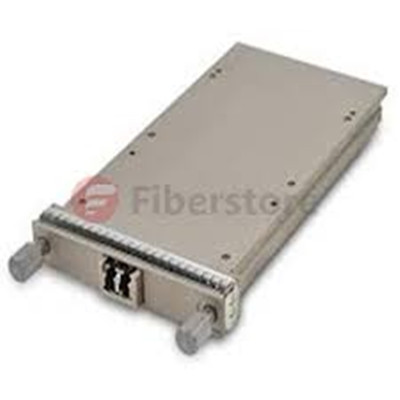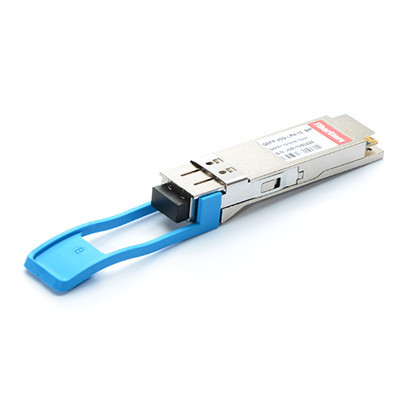In response to the increasing bandwidth demands for data centers, the IEEE introduced the 802.3ba Ethernet standard in June 2010, which lays solid foundation for the introduction of 40G and 100G Ethernet operations. Users of this new technology continue to increase as network operators need the highest data rates over a single connection. And new optical products have become popular accordingly like 40GbE transceiver modules and DAC cables. Figuring out all the 40GbE optical devices can be confusing, then let’s start with 40G CFP LR4 and QSFP 40GBASE-LR4 modules.
They are 40GbE transceiver modules. Most 40GbE ports are capable of running in a 4x10GbE mode, allowing for 10GbE/40GbE mixed media deployments. These ports can also provide the option of ultra-high 10GbE port density. Before we come to the 40G CFP LR4and QSFP 40GBASE-LR4 modules, firstly we need to have a brief overview of QSFP and CFP transceiver modules.
What Is CFP?
CFP is the C form factor optics that are available in 40GbE and 100GbE varieties. The C represents the Latin letter C, to express the number 100 (Centum) as the standard was primarily developed for the 100 Gigabit Ethernet System. CFP is a hot-pluggable optical transceiver presenting MPO connectors for multi-mode optics or SC connectors for single-mode optics. The CFP form factor supports both the single-mode and multi-mode fiber with a variety of data rates, protocols and link lengths. The optical target interface includes a 40GBase-SR4 for 100m and 40GBase-LR4 for 10km.
CFP is the C form factor optics that are available in 40GbE and 100GbE varieties. The C represents the Latin letter C, to express the number 100 (Centum) as the standard was primarily developed for the 100 Gigabit Ethernet System. CFP is a hot-pluggable optical transceiver presenting MPO connectors for multi-mode optics or SC connectors for single-mode optics. The CFP form factor supports both the single-mode and multi-mode fiber with a variety of data rates, protocols and link lengths. The optical target interface includes a 40GBase-SR4 for 100m and 40GBase-LR4 for 10km.

What Is QSFP?
QSFP ((Quad Small Form-Factor Pluggable Plus) form factor optics are the primary way of delivering 40GbE and are now appearing in 100GbE capable form that offers customers a multitude of high-density 40 Gigabit Ethernet connectivity options for data center and high-performance computing networks. These present either MPO connectors for multi-mode optics or LC connectors for single-mode optics. The 40G QSFP+ transceiver is well suited for Infiniband and 40GBASE-SR4 / 40GBASE-LR4 applications.
QSFP ((Quad Small Form-Factor Pluggable Plus) form factor optics are the primary way of delivering 40GbE and are now appearing in 100GbE capable form that offers customers a multitude of high-density 40 Gigabit Ethernet connectivity options for data center and high-performance computing networks. These present either MPO connectors for multi-mode optics or LC connectors for single-mode optics. The 40G QSFP+ transceiver is well suited for Infiniband and 40GBASE-SR4 / 40GBASE-LR4 applications.

40GBase-LR4 Standards
Both CFP and QSFP support 40GBase standards. 40GBASE-LR4 ("long range") is a port type for single-mode fiber and uses 1300nm lasers. Its Physical Coding Sublayer 64b/66b PCS is defined in IEEE 802.3 Clause 82 and its Physical Medium Dependent PMD in Clause 87. It uses four wavelengths delivering serialized data at a rate of 10.3125Gbit/s per wavelength. For more information, please visit
https://en.wikipedia.org/wiki/100_Gigabit_Ethernet
Both CFP and QSFP support 40GBase standards. 40GBASE-LR4 ("long range") is a port type for single-mode fiber and uses 1300nm lasers. Its Physical Coding Sublayer 64b/66b PCS is defined in IEEE 802.3 Clause 82 and its Physical Medium Dependent PMD in Clause 87. It uses four wavelengths delivering serialized data at a rate of 10.3125Gbit/s per wavelength. For more information, please visit
https://en.wikipedia.org/wiki/100_Gigabit_Ethernet
- 40GBASE-LR4 CFP
40GBASE CFP modules support 40GBASE Ethernet and OTU3 standards and are interoperabile with respective industry IEEE- and/or OTU3-compliant interfaces. Take Cisco 40GBASE-LR4 CFP as an example, it supports link lengths of up to 10km over a standard pair of G.652 single-mode fiber with duplex SC connectors. The 40 Gigabit Ethernet signal is carried over four wavelengths. Multiplexing and demultiplexing of the four wavelengths are managed within the device. This CFP module supports both IEEE 40GBASE-LR4 and OTU3 C4S1-2D1 standards.
- 40G QSFP+ LR4
The 40G QSFP+ LR4 is designed for long transmission distance used with single-mode fiber. And “4” here means four lanes. Additionally, they are in different wavelengths and with different connectors. When they used in actual network, they are used different technology. Take compatible Alcatel-Lucent QSFP-40G-LR as an example, it operates on single-mode fiber cable for supporting link lengths of 10km at a wavelength of 1310nm.
Summary
CFP form factor with digital diagnostics monitoring functionality (DDM) supports 40GBase-LR4 Ethernet standard that makes it ideally suited for 40GbE applications. 40GbE QSFP transceiver puts together four independent 10Gbps data lanes in each direction to deliver 40Gbps aggregate bandwidth. And there are both active and passive QSFP cable assemblies to support Fiber Channel, Infiniband, and Ethernet protocols. Fiberstore offers all kinds of 40G transceiver modules and QSFP+ cables (For example, QSFP-H40G-AOC15M is QSFP+ to QSFP+ active optical direct-attach cables supporting a short distance of 15m).
CFP form factor with digital diagnostics monitoring functionality (DDM) supports 40GBase-LR4 Ethernet standard that makes it ideally suited for 40GbE applications. 40GbE QSFP transceiver puts together four independent 10Gbps data lanes in each direction to deliver 40Gbps aggregate bandwidth. And there are both active and passive QSFP cable assemblies to support Fiber Channel, Infiniband, and Ethernet protocols. Fiberstore offers all kinds of 40G transceiver modules and QSFP+ cables (For example, QSFP-H40G-AOC15M is QSFP+ to QSFP+ active optical direct-attach cables supporting a short distance of 15m).
评论
发表评论